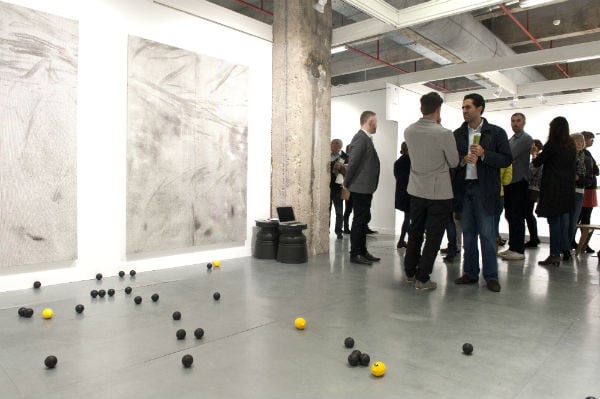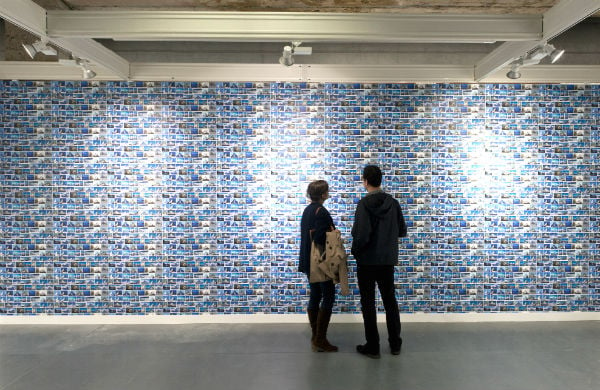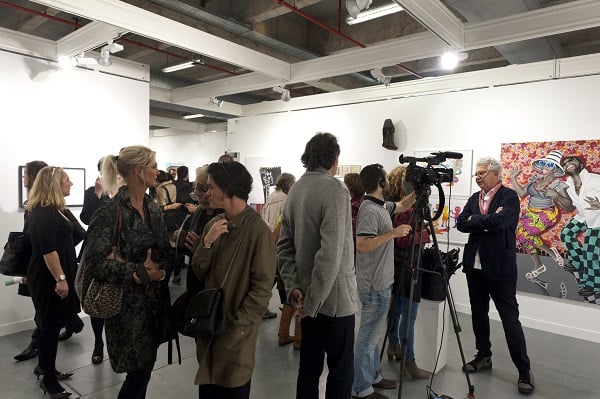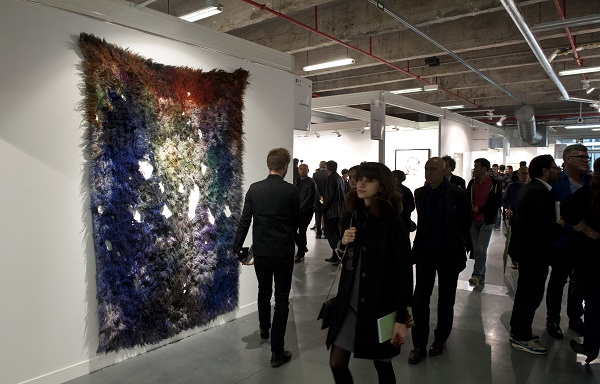Art Fairs
Paris’s New Fair (Off)icielle Attracts Collectors
With an LA outpost on the horizon, FIAC flexes its muscle at home.

With an LA outpost on the horizon, FIAC flexes its muscle at home.

Coline Milliard

Credit must be given where credit is due. France’s premier art fair FIAC has put its full weight behind its much-awaited offspring, (Off)icielle. And it’s paid off.
Months before the spring launch of its first international outpost in Los Angeles, it is flexing its muscle at home, as if for a dress rehearsal. Although (Off)icielle has so far been described as a “satellite,” it is everything but. The 68 galleries showing at Les Docks-Cité de la Mode et du Design might be on the other side of town but they are virtually part and parcel of the main fair at the Grand Palais. This new set-up brings back memories of the days when FIAC had an elegant section for younger galleries in the Louvre’s Cour Carrée. Rather then two fairs, FIAC and (Off)icielle are effectively one fair over two sites. The organizers have thus vastly increased their capacity, while guaranteeing success by granting—as rumor had it—the same VIP list to both. Smart.
Collectors are loving it. When (Off)icielle opened on Tuesday, one day ahead of the main fair, they reportedly rushed to the booths, stimulated no doubt by the relatively low price point (most of the works on show here are below €20,000). Talking to artnet News yesterday, Martin Rochford, from the young Dublin gallery Ellis King, described the preview atmosphere as a “shark-feeding frenzy,” and marveled at the number of French collectors he had met in the last 24 hours. The gallery instantly sold the six Ryan Estep “sterilized dust on canvas” abstract paintings (€16,000 each) that constitute the entire booth. Collectors Susan and Michael Hort from New York, London’s Anita Zabludowicz, Paris’s Antoine de Galbert, and Brussels’s Alain Servais were all spotted pacing the aisles, as was Caroline Bourgeois, a.k.a. François Pinault’s “third eye.”
Shannon Richardson, from LA’s M+B, told artnet News she was “really pleased with the quality of the people.” Sales naturally followed. By the second day, the west coast gallery had sold seven out of the nine Dwyer Kilcollin sand sculptures, Emergent Objects, at the booth ($3,500-7,000) and four out of five pieces by Jesse Stecklow ($4,500)—half of them to collectors who were new to the gallery. New York’s Lisa Cooley, who skipped Sunday art fair in London to come straight to (Off)icielle, was also no doubt happy with her decision, having placed two paintings by Cynthia Daignault from a spectacular series focusing on Switzerland’s Matterhorn mountain (price range: $6,000-18,000).

Lisa Cooley at (Off)icielle
Photo: Courtesy of FIAC. Etienne Pottier
There’s a real feeling that Paris could soon outshine London in the busy October art calendar. Several dealers at FIAC, including the Brussels-based Xavier Hufkens and New York’s Barbara Gladstone, have also snubbed Britain in favor of France (in their case FIAC over Frieze). The growing sense of homogenization that has been pervading Frieze for the last few years doesn’t help. “Frieze is wonderfully international, but I don’t think it’s representative of what’s going on in London,” Ed Greenacre, from London’s Rokeby, told artnet News. By contrast “FIAC has always looked after its own,” he continued, adding that Britain simply “didn’t have the same level of collecting as the continent.” Not only does that mean healthy business—Rokeby reported solid sales of paintings by Gideon Rubin in the $4,000-6,000 range—but it also gives FIAC and (Off)icielle a distinctly French flavor. More than 25 percent of the galleries at the main fair are based in the country, a proportion that reaches just under 50 percent at (Off)icielle.
This was director Jennifer Flay’s stroke of genius. At the helm of FIAC since 2003, the New Zealander has made the best of what France and Paris have to offer like no FIAC director before her, championing French galleries, stimulating local collectors, and harnessing the world-famous heritage of the City of Lights to serve her fair. FIAC has spread to some of the most desirable corners of the capital, including at the Jardins des Plantes, the Jardin des Tuileries, and the Place Vandôme (which hosted Paul McCarthy’s ill-fated “sex toy” sculpture (see “Vandalized Paul McCarthy Butt Plug Pulled from Paris Square”). “Paris had the image of a city frozen in time, a city-museum,” Parisian gallerist Anne Barrault told artnet News. “It has become a jewelry box to show contemporary art.” The choice of Les Docks – Cité de la Mode et du Design, and its striking contemporary architecture courtesy of Jakob + Macfarlane, adds another dimension, showcasing the historical city as one also embracing the future.

(Off)icielle 2014.
Photo: Courtesy of FIAC. Etienne Pottier
Barrault was one of the dealers who used to show at the Cour Carré, and was dropped when FIAC had to leave the Louvre site. She welcomed the launch of (Off)icielle, hoping it would bring back some of the edgier atmosphere she remembers of the now-defunct section. “[The Docks] is a human-sized venue, and a good format for people to truly see the artists’ work,” she said, standing in a booth presenting paintings by Guillaume Pinard and Dominique Figarella, as well as a couple of intriguing sculptures by Sarah Tritz. The Parisian gallery Hussenot, another Cour Carré veteran, is also glad to be back within FIAC’s bosom, reporting sales by the hotly-tipped London ceramicist Jesse Wine (€5,000-10,000).
There’s a certain tameness that seems to prevail over the fair that can be disappointing. (Off)icielle has gone for neat little white booths, mostly filled with conveniently portable artworks. For a fair supposedly championing emerging contemporary art, one might have expected a more experimental approach à la Art Berlin Contemporary (“abc”), or the Sunday fair. Then again, neither of these fairs are particularly renowned for their brisk sales. And (Off)icielle means business. It has a point to make.

(Off)icielle 2014.
Photo: Courtesy of FIAC. Etienne Pottier
There’s another issue. The young fair doesn’t seem to be completely clear as to what exactly it wants to be. It’s clearly not just about young galleries: (Off)icielle throws together established dealers such as Brussels’s Meessen De Clercq, Paris’s Laurent Godin, Hussenot, Barrault, and up-and-coming galleries such as Frutta in Rome or Brand New Gallery in Milan (which reported very strong sales for its painters Nico Colón and Alain Biltereyst). Exhibitors pay only a little less than they would for a spot at the Grand Palais (€445 per square meter as opposed to roughly €495-€545 per square meter at the main fair), which perhaps contributed to the confusing mix. “The identity is still to be defined,” French collector Sebastien Peyret told artnet News. “The quality of the selection is a bit hit and miss. I think it’s still an in-between phase.” Alain Servais was more scathing, taking to Twitter to describe the “interesting and strange gathering of galleries” “half of which should be at FIAC, the other which will never make it there.”
Yet this motley assortment might be pragmatic. While selecting the galleries for (Off)icielle, FIAC might well have been thinking about Los Angeles. As a former fair director pointed out, “[(Off)icielle] gives them a much broader depth of relationships to choose from when LA comes around.” Belleville’s Samy Abraham, thrilled to have placed Bruno Bottella’s sculpture Garrison (2014) in a “very good French collection,” chimed in: “Everybody is looking at (Off)icielle to see how FIAC organizes another fair,” he said. “It’s like a test.”
There might still be room for improvement, but few will deny that (Off)icielle got off to a flying start.